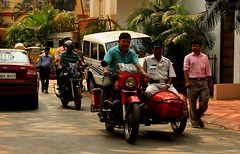
As a feminist activist and director of The 50 Million Missing Campaign to end female genocide in India, one of the questions I’m often asked in interviews is “How do we raise strong daughters?”
I have to admit, that there’s a part of me that is always uncomfortable with this question being asked in context of violence on girls and women. Because what I feel it does, is that in a round-about-way it puts the onus or blame of gender-based violence on the victim. It’s almost like saying, the reason girls and women get battered and/or killed is because they are weak. And if they weren’t they wouldn’t. Sexist and misogynist violence effects even the strongest of women, simply because the system (social, religious, legal etc.) permits it. In fact determinedly perpetuates it. Victims of violence, be it race, religion or gender based violence, are NOT inherently weak, but are weakened by constant social battering.
So I believe the process of raising strong daughters is to off-set the very social and cultural conditioning and values that are meant to rob us of our strengths and potentials as individuals. These are ideas and values that many of us, even those opposed to sexist societies, imbibe and perpetuate unconsciously. Below I talk about 10 such things that we, as mothers, fathers, teachers, and guardians need to be mindful of, in how girls are raised in society, so we don’t rob them of their inherent strengths and potentials. So that we consciously provide our daughters with an environment where they can realize and proudly assume their powers in full. And are able to let “their strong woman within” shine through.
1.Teach her to know her Self by listening to her inner voice, instincts, thoughts and inclinations.
2. Teach her to be comfortable with what’s different in her even when it is at odds with what society says she should be.
3. Teach her that she is exceptional in her own way, and that you are going to be by her side as she discovers, explores and expresses her individual identity.
4. Teach her that choices she makes come with responsibilities that she must also assume. But that they also come with the freedom to make a new choice if she finds her first choice to be wrong.
5. Teach her that she has the right to be wrong, and that’s the path of discovery and growth.
6. Teach her that if she believes in herself, and her dreams and goals, she does not need the approval of the whole world.
7. Teach her that she will face harshness in this society, and she will face rejection, and that it does not matter as long as she believes in who she is and what she is doing.
8. Teach her to value experiences and work that allow her to be herself.
9. Teach her to value people who love her for who she is not what she does or has.
10. Teach her to celebrate each time she takes a stand against social or cultural pressure to conform and stands true to what she knows and believes in, even if at the end of the day, she won’t get a public award or standing ovation for it.














